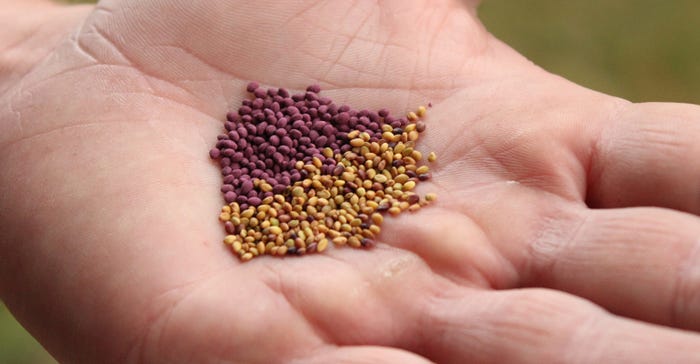
If your alfalfa field is now 5 or 6 years old and starting to lose fullness, overseeding that field with Frosty berseem clover might be a way to beef up your hay harvest through the summer.
"At the end of March when fields green up and start growing is a good time to check and see what kind of stand you've got," says Jason Stucky, a cover crop seedsman in Valley Center. "Overseeding clover can bump up the protein in the hay, but you still have basically an alfalfa-based feed."
Berseem clover looks more like alfalfa than the typical red or white clover crops that many farmers are familiar with, he says.
"It can even be a little hard to tell the clover from the alfalfa," he says.
Crude protein levels in Frosty clover have been measured ranging from 16.5% to 22.1%, with relative feed values measured as high as 182.
Recent studies have shown that an 80-20 alfalfa-berseem clover mix could increase yield, crude protein, and water-soluble carbohydrate levels in hay fields. Hay yields were reported to be increased by more than 30%.

SEED IN HAND: Frosty berseem clover seed can be treated or untreated and used either as part of a forage cover crop mix or overseeded into alfalfa fields to increase nutritional value and yield.

In addition to being an excellent choice for supplementing alfalfa fields, Frosty is a good component for a forage cover crop mix, Stucky says, because it can be both grazed and baled for hay.
Adding crimson clover to an existing brome or prairie grass pasture is also a way to extend the grazing season and add some nutrition, he says.
"There's a brand called Kentucky Pride that just came out for grazing," Stucky says. "It is a little more winter-hardy and breaks dormancy earlier."
For farmers with backyard chicken flocks, crimson clover has another purpose: Chickens love it, and it makes for deep yellow, good-tasting egg yolks.
Crimson clover adds nitrogen to the soil and additionally functions as a good "green manure" crop, Stucky says.
About the Author(s)
You May Also Like




